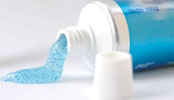

No one really thinks about whether the toothpaste itself is clean when they are cleaning their teeth, so it is only in recent years that vision systems have been used to check whether the actual product packaging is clean and safe before toothpaste tubes are filled. Previously, filling systems that were not equipped with a machine vision system could not completely guarantee that particles of dirt from the preliminary tube production stage would not be inside the tube after the filling and sealing process. A German manufacturer relies on vision systems from Cognex in its newest packaging machine. During the course of the filling process, the In-Sight vision systems check that the tubes are round, clean, and firmly sealed. In-process inspection has allowed the number of cameras to be reduced from the six conventional units required in the old process to just two In-Sight systems per checking station.
500 tubes per minute
With a capacity of up to 500 tubes per minute, the packing machine inspects, fills and seals toothpaste tubes in record time. Even though materials of high quality are used, there can still be contamination by small dirt particles, tubes may be deformed when the outer packaging is applied or there may be faulty seals at the base of the tube. To ensure that their production processes are fault-free, two In-Sight 5100 and 5400 cameras are installed on each of three inspection stations. Each camera monitors a set of parallel conveyer rows with tube holders.
Complete inspection – print position, cap, and tube shape
During the first operation step, the tubes are placed in the tube holders of the conveyor system. The screw cap is in place at the top of the tube and the lower end is open for the filling procedure. The conveyor system moves the tubes towards the cleaning and filling station. Before they reach the cleaning and filling station, a scanner checks that the tubes are aligned correctly so that the printing is in the correct position. Two successive inspection stations check that the tubes are round in shape and clean before they go through cleaning and filling stage.
Two In-Sight 5100 cameras installed above the conveyor evaluate the tube ground coat, the shoulders of the tube, and the inside of the tube cap during the particle check. The cameras also detect foreign bodies based on the contrast to their surroundings. During the subsequent tube roundness check, two In-Sight 5100s ensure that the filling nozzles enter the tubes accurately. The cameras record pictures of the packages as they move past. If a tube is out-of-round or outside of the tolerance range, it is identified as faulty and is not filled.
Seal verification
After cleaning and filling, the laminated plastic tubes are sealed with hot air. The ends of the tube are heated by hot air and are then pressed together by cooled stamping jaws. The seal is either stamped smooth or in a corrugated pattern and may feature a serial number or code. Defects can occur at this stage of the packaging process. For example, if a knife becomes blunt and can no longer cut off the ends of the tubes correctly, the seal will be left with rough edges. In the trimming station, two In-Sight 5400 cameras ensure that all faulty packages are detected without fail. The cameras also check the seal itself. If the seal is not complete, or if the printing is not properly aligned with the specified parameters, the faulty tube is ejected from the process.
Reporting
The In-Sight vision systems are networked to a central panel PC which records all of the images of faulty pieces. This makes it possible to detect faults quickly without having to recheck the actual item of packaging that has already been ejected from the process. The packaging process is thus very reliable in terms of the quality standards achieved.
| Tel: | +27 11 787 0473 |
| Email: | [email protected] |
| www: | www.westplex.co.za |
| Articles: | More information and articles about Westplex |

© Technews Publishing (Pty) Ltd | All Rights Reserved